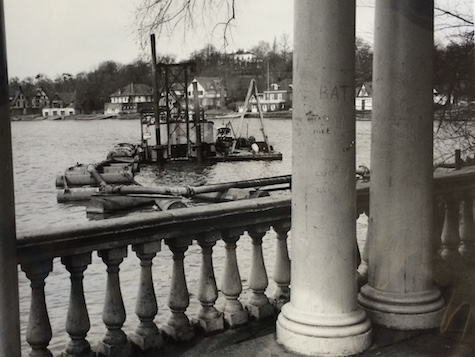After two years of fruitless lobbying of the U.S. Corps of Army Engineers to dredge the Schuylkill River, Philadelphia area colleges, boat clubs, the city, the state and numerous individuals have raised close to the $4.5 million price tag, enough to move forward.
The announcement came Wednesday at the city’s historic Boathouse Row, with Mayor Kenney, presidents of area universities, major donors and others touting the teamwork it took to pull this off. The river had become so shallow near the boathouses that some feared a boat might get its oars stuck, or a motorized coach boat might stall and be swept over the dam at the Water Works. Even more critically for the regattas, some of the racing lanes had become shallower than others, which cuts the speed of boats rowing in those lanes, putting them at a disadvantage.
Kenney reminded that it’s been 20 years since the last dredge near the dam and 50 years since the race course was dredged and called the regattas “economic drivers for what they bring to the city,”
Dr. Amy Gutmann, president of the University of Pennsylvania, which was the largest single contributor to the effort, praised the collaboration among all stakeholders. “We all rowed in the same direction,” she said.
In just weeks, two of the crown jewels of Philadelphia racing take place on the Schuylkill. On May 10-11, the largest collegiate regatta in North America —the Dad Vail—happens here, with 100 colleges from the U.S and Canada competing in its 81st year.
Then it’s the Stotesbury Regatta (May 17-18), when kids from 200 high schools will compete in the largest high school regatta in the world. Its history dates back to 1927 when Edward T. Stotesbury, a banker and one of the nation’s wealthiest men, donated a silver cup for a “schoolboys’ race.” (It is one of the ironies of history that donating a silver cup was for Mr. Stotesbury one of the smallest gestures of his illustrious life, so insignificant that it was not even mentioned in the many pages of news stories devoted to his obituary in 1938. Yet this is the only thing for which he is today remembered.)
The Schuylkill Navy, the umbrella organization for the area’s rowing clubs, which spearheaded the dredging effort, sought $4.5 million to pay for it when the federal government, which has long supported dredging, gave it a lower priority. Nearly $2 million was donated by the seven major rowing colleges—the University of Pennsylvania ($750,000), Temple University ($500,000), Drexel ($500,000), St. Josephs ($50,000) , LaSalle ($50,000), Villanova ($25,000), and Jefferson University ($25,000).
The city and state also kicked in about $500,000 each. Members of the clubs of Boathouse Row, which make up the Schuylkill Navy, all contributed. And some major private donors also gave significant sums, including Bill McNabb, former CEO of Vanguard; Tony Schneider, who is a major supporter of Philadelphia City Rowing for middle and high school students in the city; and philanthropist Edith Dixon.
More is still needed, which you can give at https://boathouserow.org/improve-river-infrastructure/
David Kahn, associate general counsel for the University of Pennsylvania, who helped coordinate the universities’ giving, said the biggest challenge was the short time frame to identify funders and work out the details of their contributions so the dredging could be contracted and rowing and racing could continue. “Big institutions don’t always move quickly,” he said.
Coming up with funding for dredging was seen as not only critical to rowers but to the city. The regattas are part of the economic fabric of Philadelphia, not to mention its history, as thousands of students, parents and spectators celebrate the increasingly popular sport. Crew is also a foundational sport for colleges like Penn, which has one of the oldest programs in the country, dating from 1872. And just as a symbol for the city, Boathouse Row is irreplaceable, with its lights that outline the charming 19th century boathouses now one of Philadelphia’s most photographed scenes.
A shout-out for this effort should also go to my former colleague at the Philadelphia Inquirer, Frank Kummer, who has been writing about the dredging issue for more than a year. And for those who’ve turned up at my talks, I pounded the table, too.!

Dredging has posed a regular crisis about every 15-to-20 years for the Schuylkill. Silt collects because of the dam, which is actually the reason rowing began on the river in 1821. That’s when an expensive, cantankerous wood-burning system to provide drinking water to the city of Philadelphia was replaced. The original system, which failed often, created steam to pump water to the plateau (Faire Mount) where the Art Museum now sits. The water then drained down into the city through wooden pipes. Its 1821 replacement was a hydraulic system that powered waterwheels to do the pumping. The dam channeled the water into the wheels. The water system was gone by the end of the 19th century, and today the Art Museum sits on the hill, overlooking more than 150 years of history.
